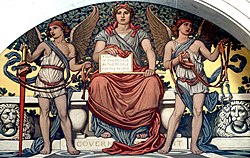South Africa national debt
The national debt of South Africa is the total quantity of money borrowed by the Government of South Africa at any time through the issue of securities by the South African Treasury and other government agencies.

As of 2021/22 total South African government debt was $130 billion.[1] The country's debt to GDP ratio in October 2020 was calculated at 82.76% of GDP by the International Monetary Fund.[2]
Roughly 90% of the national debt in 2019/20 was denominated in South African rand thereby reducing borrowing risk due to currency fluctuations.[3] By September 2020 around US$157 billion of South Africa's national debt was externally owned.[4] As of December 2021 the share of domestic bonds held by foreign investors was 28.2%, this represented a declined to a 10-year low.[1]
History
Apartheid era
During apartheid South Africa faced a worsening financial situation stemming from an economic recession and increasing international sanctions in the 1980s.[5] In 1980 the country's total debt amounted to US$16.9 billion, representing a debt to GDP ratio of 20%.[5] By 1984 the country's debt had increased to US$24.3 billion representing a debt to GDP ratio of 46%.[5] The deteriorating political situation stemming from apartheid policies resulted in "huge capital outflows and a temporary closure of foreign exchange markets" between 1984 and 1985.[6] In August 1985 the stability of South Africa's financial situation was put under severe pressure following P.W. Botha's Rubicon speech.[7] The speech and the lack of commitment by the government to roll back apartheid legislation resulted in a sovereign default[8] on the debt when global lenders refused to rollover South Africa's debts.[9] The final payment of $6.89 billion on the $13.6 billion 1985 debt was made by the South African government in 2001.[6]
Post-apartheid era
Graphs are unavailable due to technical issues. Updates on reimplementing the Graph extension, which will be known as the Chart extension, can be found on Phabricator and on MediaWiki.org. |
South Africa's national debt was effectively reduced during the Mandela and Mbeki administrations. The debt significantly increased from 2008 onwards during the presidencies of Jacob Zuma and Cyril Ramaphosa.[11]
By 2009 South Africa's debt to GDP ratio dropped to 28% from 34.6% in 2006.
Future expectations of the debt

As of 2020, at current rates of expenditure and revenue generation it is expected that by 2028/29 the country's debt to GDP ratio will exceed 100%.
See also
- List of countries by public debt
- Economy of South Africa
- Taxation in South Africa
External links
| Public finance |
|---|
 |
| Part of a series on the |
| Politics of South Africa |
|---|
 |
|
|
References
- ^ a b Felix, Jason. "In just five years, SA has borrowed R1.8 trillion from investors - Enoch Godongwana". News24. Retrieved 2022-04-18.
- ^ "Gross debt position : % of GDP". www.imf.org. Retrieved 2021-03-01.
- ^ "Government debt and contingent liabilities" (PDF). South African National Treasury. 26 February 2020.
- ^ "South Africa External Debt, 1985 – 2021 Data". www.ceicdata.com. Retrieved 2021-02-26.
- ^ )
- ^ a b "Apartheid debt settled". Fin24. Retrieved 2021-06-09.
- ^ Rossouw, Jannie. "South Africa is on a cliff edge – just as it was in 1985". The Conversation. Retrieved 2021-06-09.
- ^ Bohoslavsky, J.P.; Raffer, K. (July 2017). "Don't Waste a Serious Crisis : Lessons from South Africa's Debt Crisis in "Sovereign Debt Crises: What have we learned?"". Cambridge University Press.
- ^ Sachs, Michael (23 April 2021). "Fiscal dimensions of South Africa's crisis" (PDF). University of the Witwatersrand. p. 4. Retrieved 9 June 2021.
- The World Bank Group. Retrieved 27 March 2022.
- ^ Jacobs, Shaun (8 October 2024). "South Africa running out of money". Daily Investor. Retrieved 9 October 2024.
- ^ "Was World Cup 2010 worth it?". The Mail & Guardian. 2015-06-11. Retrieved 2021-06-09.
- ^ "South Africa was not a Fifa success story". Rosa Luxemburg Foundation. 2014-09-28. Retrieved 2021-06-09.
- ^ a b Schoeman, Mark; Creamer, Kenneth (2015). "Public Debt in Post-Crisis South Africa" (PDF).
- ^ "South Africa sees government debt exceeding 100% of GDP". 20 June 2020. Retrieved 2021-02-26.
- ^ "South Africa sees government debt at 113.8% of GDP in 2029". Moneyweb. 2020-06-20. Retrieved 2021-02-26.
- ^ Cohen, Ed Stoddard and Tim (2020-08-31). "Business Maverick: South Africa's odious debt tale". Daily Maverick. Retrieved 2021-02-26.
- ^ Friederich, Jan (28 October 2020). "South Africa Debt Stabilisation Depends on Wage Negotiations". www.fitchratings.com. Retrieved 2021-02-26.
